
V1974 Cygni or Nova Cygni 1992 was a nova, visible to the naked eye, in the constellation Cygnus. It was discovered visually with 10×50 binoculars on February 19, 1992, by Peter Collins, an amateur astronomer living in Boulder, Colorado. At that time he first noticed it, it had an apparent magnitude of 7.2. Nine hours later he saw it again, and it had brightened by a full magnitude. For this discovery Collins was awarded the AAVSO Nova Award in 1993. The nova reached magnitude 4.4 at 22:00 UT on 22 February 1992. Images from the Palomar Sky Survey taken before the nova event showed identified a possible precursor which had photographic magnitudes of 18 and 17, but the identification of the precursor is not firm.

T Aurigae was a nova, which lit up in the constellation Auriga in 1891. Thomas David Anderson, an amateur astronomer in Edinburgh, reported that he was "almost certain" he saw the nova at 02:00 UT on 24 January 1892, when it was slightly brighter than χ Aurigae. He mistook the star for 26 Aurigae, although he noted to himself that it seemed brighter than he remembered it being. He saw it twice more during the following week. On 31 January 1892 he realized his mistake, and wrote a note to Ralph Copeland reporting his discovery. Professor Copeland immediately reported the discovery via telegram to William Huggins, who made the first spectroscopic observations of T Aurigae on 2 February 1892, when the star was a magnitude 4.5 object. T Aurigae was the first nova to be observed spectroscopically.
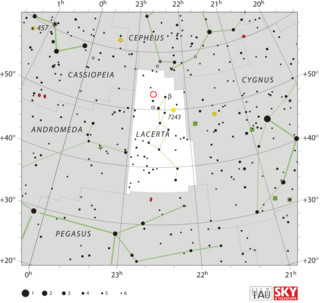
DI Lacertae or Nova Lacertae 1910 was a nova in constellation Lacerta which appeared in 1910. It was discovered by Thomas Henry Espinell Compton Espin at Wolsingham Observatory on 30 Dec 1910, at which time it was an 8th magnitude object. Subsequent examination of pre-discovery photographic plates showed that the outburst occurred sometime between 17 November 1910 and 23 November 1910. It reached a peak brightness of magnitude 4.6 on 26 November 1910, making it visible to the naked eye. Before the nova event DI Lacertae was a 14th magnitude star, and by 1950 it had returned to 14th magnitude.

BT Monocerotis was a nova, which lit up in the constellation Monoceros in 1939. It was discovered on a spectral plate by Fred L. Whipple on December 23, 1939. BT Monocerotis is believed to have reached mag 4.5, which would have made it visible to the naked eye, but that value is an extrapolation; the nova was not observed at peak brightness Its brightness decreased after the outbreak by 3 magnitudes in 182 days, making it a "slow nova". The light curve for the eruption had a long plateau period.

V533 Herculis was a nova visible to the naked eye, which occurred in 1963 in the constellation of Hercules.

NQ Vulpeculae also known as Nova Vulpeculae 1976, was a nova that appeared in the constellation Vulpecula in 1976. It was discovered visually at 18:20 UT on October 21, 1976 by English amateur astronomer George Alcock. Its apparent magnitude at the time of discovery was 6.5 It reached its maximum brightness of magnitude 6.0 thirteen days after its discovery, at which point it may have been faintly visible to the naked eye. A few days after maximum brightness, it had faded to magnitude 8.3.

DK Lacertae was a nova, which lit up in the constellation Lacerta in 1950. The nova was discovered by Charles Bertaud of the Paris Observatory on a photographic plate taken on 23 January 1950. At the time of its discovery, it had an apparent magnitude of 6.1. DK Lacertae reached peak magnitude 5.0, making it easily visible to the naked eye.
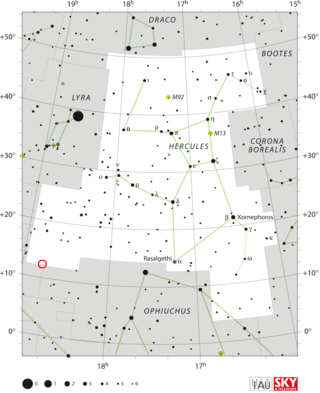
V838 Herculis, also known as Nova Herculis 1991, was a nova which occurred in the constellation Hercules in 1991. It was discovered by George Alcock of Yaxley, Cambridgeshire, England at 4:35 UT on the morning of 25 March 1991. He found it with 10×50 binoculars, and on that morning its apparent visual magnitude was 5. Palomar Sky Survey plates showed that before the outburst, the star was at photographic magnitude 20.6 and 18.25.
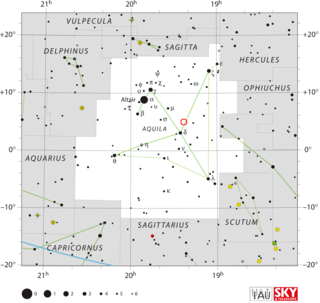
V1494 Aquilae or Nova Aquilae 1999 b was a nova which occurred during 1999 in the constellation Aquila and reached a brightness of magnitude 3.9 on 2 December 1999. making it easily visible to the naked eye. The nova was discovered with 14×100 binoculars by Alfredo Pereira of Cabo da Roca, Portugal at 18:50 UT on 1 December 1999, when it had a visual magnitude of 6.0.
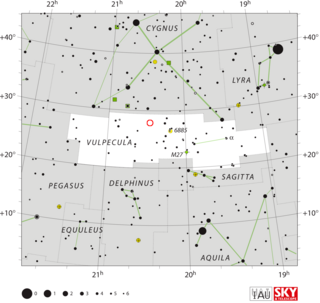
QU Vulpeculae, also known as Nova Vulpeculae 1984 Number 2, was the second nova which occurred in 1984 in the constellation Vulpecula. It was discovered by Peter Collins, an amateur astronomer from Cardiff, California at 22:08 UT on 22 December 1984. At the time of its discovery, the nova's apparent magnitude was 6.8. By the next night, Collins reported its brightness had increased to magnitude 5.6, making it visible to the naked eye.

V1059 Sagittarii was a nova, which lit up in 1898 in the constellation Sagittarius. The star reached apparent magnitude 4.5, making it easily visible to the naked eye. It was discovered on 8 March 1898, by Williamina Fleming on a photographic plate taken at the Harvard College Observatory. The discovery plate was an objective prism plate, part of the Henry Draper Memorial Photographs, and Ms Fleming identified it as a nova based on its spectral characteristics.

WZ Sagittae is a cataclysmic dwarf nova star system in the constellation Sagitta. It consists of a white dwarf primary being orbited by a low mass companion. The white dwarf is about 0.85 solar masses while the companion is only 0.08 solar masses. This implies that the companion is a spectral class L2 star, although this has yet to be confirmed. The distance to this system has been determined by parallax, yielding a distance of 45.1 parsecs.

V630 Sagittarii was a nova visible to the naked eye in 1936. It was discovered on 3 October 1936 by Shigeki Okabayashi of Kobe, Japan when it had an apparent magnitude of 4.5.
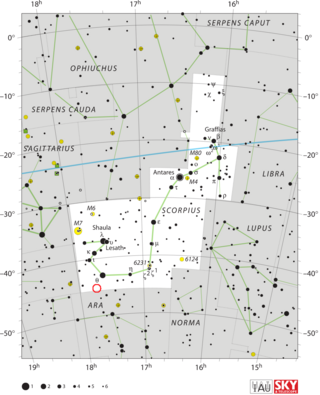
V728 Scorpii, also known as Nova Scorpii 1862, was a nova that occurred in the constellation of Scorpius. It was discovered on 4 October 1862 by John Tebbutt, an astronomer living in New South Wales, Australia, while he was observing a comet. He reported that the star was in the constellation Ara. At the time of its discovery, the nova had an apparent magnitude of 5, making it visible to the unaided eye. Nine days later it had faded to below 11th magnitude, indicating that it was a very fast nova.
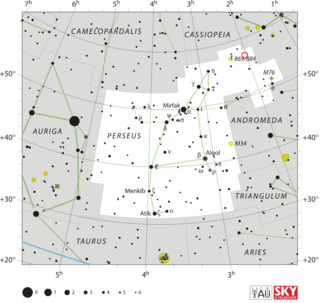
V Persei, also known as Nova Persei 1887 was discovered by Williamina Fleming on a Harvard College Observatory objective-prism photograph taken on 3 November 1887. It is believed to be the first nova whose spectrum was recorded. The nova had an apparent magnitude of 9.2 at the time of discovery. Judging from the consistency of the nova's brightness after discovery, and details of the spectral lines seen, McLaughlin estimated that the nova was five or six months past peak brightness at the time of its discovery, and at its peak it was almost certainly at least as bright as 4th magnitude. So V Persei was probably visible to the naked eye, though there is no record that anyone actually noticed it when that was possible. It is currently an 18th magnitude object.

V368 Aquilae, also known as Nova Aquilae 1936 no. 2 was the second nova which occurred in the constellation of Aquila during 1936. It was discovered on a photographic plate by Nils Tamm at Kvistaberg Observatory on 7 October 1936. At the time of discovery it was at photographic magnitude 7, and was already fading. Pre-discovery photographs showed that peak brightness occurred around 25 September 1936, at which time it had reached apparent magnitude 5.0, making it visible to the naked eye. The nova was described as being fiery red due to strong Hα emission, and for a time could be seen with binoculars simultaneously with V356 Aquilae, another nova which Nill Tamm had discovered a month earlier.

QZ Aurigae, also known as Nova Aurigae 1964, was a nova which occurred in the constellation Auriga during 1964. It was discovered by Nicholas Sanduleak on an objective prism photographic plate taken at the Warner and Swasey Observatory on 4 November 1964. Examination of pre-discovery plates from Sonneberg Observatory showed that the eruption occurred in early February 1964, and it had a photographic magnitude of 6.0 on 14 February 1964. Its brightness declined in images taken after the 14th, suggesting that its peak brightness was above 6.0. It was probably visible to the naked eye for a short time.

V1370 Aquilae, also known as Nova Aquilae 1982, is a nova that appeared in the constellation Aquila during 1982. It was discovered by Minoru Honda of Kurashiki, Japan at 20:30 UT on 27 January 1982. At that time the Sun had moved just far enough from Aquila to allow the nova to be seen in the morning sky. Although it was discovered photographically, its apparent magnitude was 6–7, making it potentially visible to the naked eye under ideal conditions. A possible magnitude 20 progenitor was located on the Palomar Sky Survey prints. Spectra of the object were taken in February 1982 at Asiago Astrophysical Observatory, which confirmed that it is a nova.

Abell 63 is a planetary nebula with an eclipsing binary central star system in the northern constellation of Sagitta. Based on parallax measurements of the central star, it is located at a distance of approximately 8,810 light years from the Sun. The systemic radial velocity of the nebula is +41±2 km/s. The nuclear star system is the progenitor of the nebula and it has a combined apparent visual magnitude of 14.67. During mid eclipse the magnitude drops to 19.24.
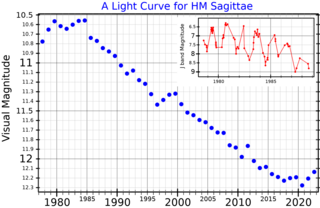
HM Sagittae is a dusty-type symbiotic nova in the northern constellation of Sagitta. It was discovered by O. D. Dokuchaeva and colleagues in 1975 when it increased in brightness by six magnitudes. The object displays an emission line spectrum similar to a planetary nebula and was detected in the radio band in 1977. Unlike a classical nova, the optical brightness of this system did not rapidly decrease with time, although it showed some variation. It displays activity in every band of the electromagnetic spectrum from X-ray to radio.





















